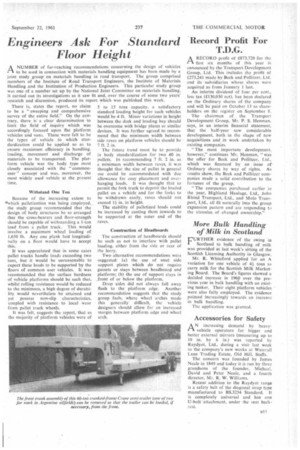Engineers Ask For Standard Floor Height
Page 49

If you've noticed an error in this article please click here to report it so we can fix it.
1-1. A NUMBER of far-reaching recommendations concerning the design of vehicles
to be used in connection with materials handling equipment has been made by a joint study group on materials handling in road transport. The group comprised members of the Institute of Road Transport Engineers, the Institute of Materials Handling and the Institution of Production Engineers. This particular study group was one of a number set up by the National Joint Committee on materials handling. It carried out its investigations as it saw fit and, over the course of some two years' research and discussion, produced its report which was published this week.
There is, states the report, no claim to be a "sweeping and comprehensive survey of the entire field." On the contrary, there is a clear determination to limit the field of inquiry which was accordingly focused upon flat platform vehicles and vans. These were felt to he the types of vehicle fo which standardization could be applied so as to ensure maximum efficiency in handling. loading, movement and discharge of materials to be transported. The platform vehicle was the body type most closely associated with the " commonuser " concept and was, moreover, the most widely used vehicle at the present time.
Withstand One Ton Because of the increasing extent to palletization was being employed. the study group recommended that the design of body structures be so arranged that the cross-hearers and floor-strength should be capable of withstanding a 1-ton load from a pallet truck. This would involve a maximum wheel loading of 1,650 lb. Any one plank laid longitudinally on a floor would have to accept this.
It was appreciated that in some cases pallet trucks handle loads exceeding two tons, but it would be unreasonable to expect these loads to be supported by the floors of common user vehicles. It was recommended that the surface hardness of vehicle platforms should be such that, whilst rolling resistance would be reduced to the minimum, a high degree of durability would nevertheless be attained and yet possess non-slip characteristics, coupled with resistance to local wear from pallet truck wheels.
It was felt, suggests the report, that as the majority of platform vehicles were of
5 to 15 tons capacity, a satisfactory standard loading height for such vehicles would be 4 ft. Minor variations in height between the deck and loading bay should be overcome with bridge plates or similar devices. It was further agreed to recommend that the minimum width between side raves on platform vehicles should be 7 ft. / in.
The future trend must be to provide in body standardization for two 40 in. pallets. In recommending 7 ft. 2 in. as a minimum width between raves, it was thought that the size of pallet in general use could be accommodated with due allowance for easy placement and overhanging loads. It was thought that to permit the fork truck to deposit the loaded pallet on a vehicle and for the forks to be withdrawn easily, raves should not exceed 1+ in. in height.
The stability of palletized loads could be increased by canting them inwards to be supported at the outer end of the raves.
Construction of Headboards The construction of headboards should be such as not to interfere with pallet loading, either from the side or rear of the lorry.
Two alternative recommendations were suggested: (a) the use of steel side support plates which do not require gussets or stays between headboard and platform; (b) the use of support stays in front of or below the platform.
Drop sides did not always fall away flush to the platform edge. Another recommendation suggests that the study group feels, where wheel arches made this generally difficult, the vehicle designers should allow for an increased. margin between platform edge and wheel arch.




































































































































